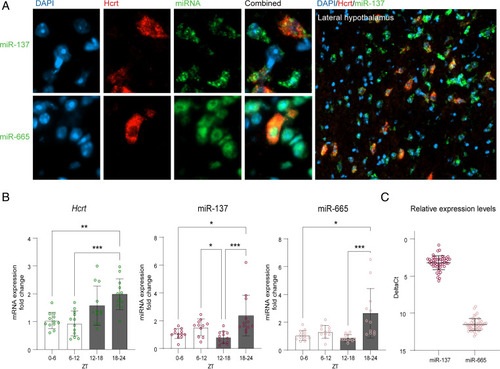Fig. 3
- ID
- ZDB-FIG-220725-57
- Publication
- Holm et al., 2022 - The evolutionarily conserved miRNA-137 targets the neuropeptide hypocretin/orexin and modulates the wake to sleep ratio
- Other Figures
- All Figure Page
- Back to All Figure Page
|
Correlation between hypocretin expression and miRNA diurnal variations. (A) Single neurons from mouse brain sections that were immunostained with HCRT-specific antibody (red) following in situ hybridization with LNA-mmu-miR-137-3p or LNA-mmu-miR-665-3p-specific probes (green). Upper Right shows colocalization of mmu-miR-137-3p with Hcrt-positive cells in the lateral hypothalamus of the mouse brain. All detected Hcrt neurons coexpressed miR-137. (B) Expression of miR-137, miR-665, and Hcrt mRNA in the mouse hypothalamus at different zeitgeber time intervals (ZTs). The gray bars represent the dark phase; n = 12/group animals at each time interval. Data were analyzed with the nonparametric Kruskal–Wallis test followed by Dunn’s multiple comparisons of all time points compared to all other time points *P < 0.05; **P < 0.01; ***P < 0.001. (C) Relative expression levels of miR-137 and miR-665 in the hypothalamus. DeltaCt is the difference between the level of two endogenous control genes U6 and SNO202 as measured by qRT-PCR and the miR level. High deltaCt equals a low expression level, and therefore, we depict the y axis in reverse. n = 48/group. |

